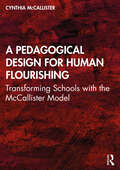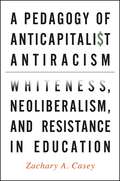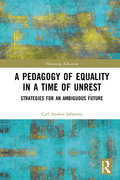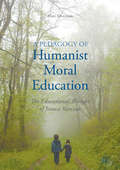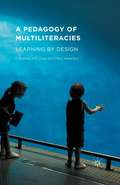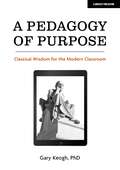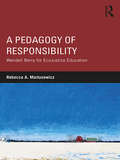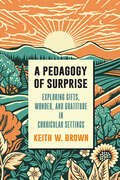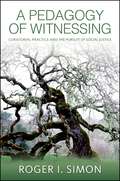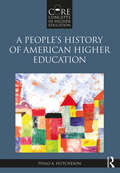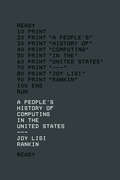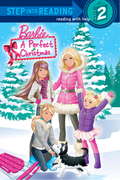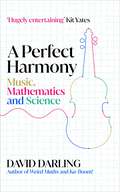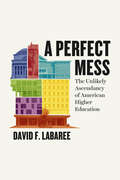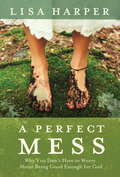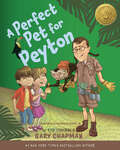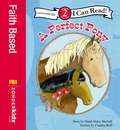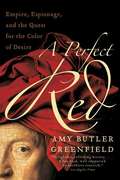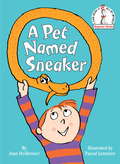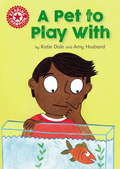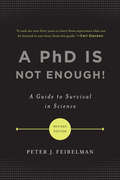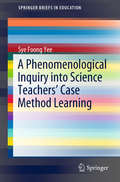- Table View
- List View
A Pedagogical Design for Human Flourishing: Transforming Schools with the McCallister Model
by Cynthia McCallisterIn A Pedagogical Design for Human Flourishing: Transforming Schools with the McCallister Model, Cynthia McCallister presents a revolutionary paradigm for education that is practical, conceptually convincing, and grounded in contemporary behavioral science theory. Beginning with the assertion that equality of educational opportunity depends on access to experiences that are sufficiently appropriate and rich to enable the achievement of diverse human potentials, she provides a comprehensive school design for intervention that demonstrates how to achieve it. Grounded in recent advances in learning science, McCallister asserts three necessary conditions for learning: the need for learners to have access to diverse, rich environmental experiences; the need for them to enjoy fundamental freedom and autonomy to direct their own learning; and access to full and free forms of association. In her model, these conditions provide what is necessary for learners to coordinate their minds with others to develop their identities, personalities, and talents. These conditions are animated in concrete procedures that can be adapted to a wide variety of populations in formal, informal, and remote educational settings. The procedures take the form of rules that learners comply with in the exercise of their freedom. When they are followed, the rules provide a grammar for the social norms that govern the moral worlds of learners and compel them to flourish. Tested over two decades in her work as a teacher, scholar, and school reformer in more than 20 NYC public schools, the McCallister Method has delivered an innovative and disruptive approach to schooling that has proven successful in finally transforming low-performing industrial schools into 21st-century learning organizations. Online support material includes assessments, records, surveys, and more to be used in school design and classroom settings.
A Pedagogy of Anticapitalist Antiracism: Whiteness, Neoliberalism, and Resistance in Education
by Zachary A. CaseyWinner of the 2018 Outstanding Book Award presented by the Society of Professors of EducationThrough an analysis of whiteness, capitalism, and teacher education, A Pedagogy of Anticapitalist Antiracism sheds light on the current conditions of public education in the United States. We have created an environment wherein market-based logics of efficiency, lowering costs, and increasing returns have worked to disadvantage those populations most in need of educational opportunities that work to combat poverty. This book traces the history of whiteness in the United States with an explicit emphasis on the ways in which the economic system of capitalism functions to maintain historical practices that function in racist ways. Practitioners and researchers alike will find important insights into the ways that the history of white racial identity and capitalism in the United States impact our present reality in schools. Casey concludes with a discussion of "revolutionary hope" and possibilities for resistance to the barrage of dehumanizing reforms and privatization engulfing much of the contemporary educational landscape.
A Pedagogy of Equality in a Time of Unrest: Strategies for an Ambiguous Future (Theorizing Education)
by Carl Anders SafstromA Pedagogy of Equality in a Time of Unrest addresses education and teaching as fundamental democratic forms of equality. It offers an alternative route for democracy and education and shows how particular shifts in ways of thinking and practising can lead to an education in favour of a democratic life for all. The book identifies the distributive paradigm in education, and dismantles central aspects of such a paradigm. It revolves around the themes of equality, commitment, change, emancipation, freedom and ambiguity, all set in relation to the distinction between schooling and education. Drawing on a range of theorists such as Jacques Rancière and Judith Butler, as well as the early Sophists, the book develops strategies to counteract any attempts to close down opportunities of emancipation through education. This book will be of great interest to academics, researchers and postgraduate students in the fields of the philosophy of education, history of education, critical sociology of education and educational theory. It will also appeal to activists and those interested in emancipatory forms of education and pluralist democracy.
A Pedagogy of Humanist Moral Education: The Educational Thought of Janusz Korczak
by Marc SilvermanThis book sheds new light on the life and work of Janusz Korczak, the twentieth century humanist moral educator and path-breaking social-pedagogue who is generally unknown in the English speaking world. In the two orphanages he led in Warsaw, Poland Korczak developed an innovative array of educational practices that motivated children from broken families suffering from serious social-interpersonal pathologies to re-form themselves during the five to seven years they lived in the orphanage. By offering its readers a systematic presentation of Korczak's worldview, educational philosophy and work, and exposing them to a rich selection of his writings, this book seeks to inform the English speaking educated public about an educator who unceasingly strived to make the world a better place for people and to make better people for the world.
A Pedagogy of Multiliteracies: Learning by Design
by Bill Cope Mary KalantzisThe concept of 'Multiliteracies' has gained increasing influence since it was coined by the New London Group in 1994. This collection edited by two of the original members of the group brings together a representative range of authors, each of whom has been involved in the application of the pedagogy of Multiliteracies.
A Pedagogy of Purpose: Classical Wisdom for the Modern Classroom
by Dr Gary KeoghA Pedagogy of Purpose offers a completely fresh take on key problems in the education system. Gary Keogh argues that the education system has lost its way; it has become mechanistic, vapid, driven by an obsession with dubious measurements and led by a very narrow understanding of what it means to succeed. It has lost its sense of purpose. Using many real classroom examples, Keogh provides a new way forward, demonstrating how insights from classical philosophy can have a positive influence on crucial issues in education like student behaviour, assessment, attendance, the quality of teaching and learning, and perhaps most importantly, the mental health of students and teachers.
A Pedagogy of Purpose: Classical Wisdom for the Modern Classroom
by Dr Gary KeoghA Pedagogy of Purpose offers a completely fresh take on key problems in the education system. Gary Keogh argues that the education system has lost its way; it has become mechanistic, vapid, driven by an obsession with dubious measurements and led by a very narrow understanding of what it means to succeed. It has lost its sense of purpose. Using many real classroom examples, Keogh provides a new way forward, demonstrating how insights from classical philosophy can have a positive influence on crucial issues in education like student behaviour, assessment, attendance, the quality of teaching and learning, and perhaps most importantly, the mental health of students and teachers.
A Pedagogy of Responsibility: Wendell Berry for EcoJustice Education
by Rebecca A. MartusewiczDrawing on the theories of author and conservationist Wendell Berry for the field of EcoJustice Education, this book articulates a pedagogy of responsibility as a three-pronged approach grounded in the recognition that our planet balances an essential and fragile interdependence between all living creatures. Examining the deep cultural roots of social and ecological problems perpetuated by schools and institutions, Martusewicz identifies practices, relationships, beliefs, and traditions that contribute to healthier communities. She calls for imaginative re-thinking of education as an ethical process based in a vision of healthy, just, and sustainable communities. Using a critical analytical process, Martusewicz reveals how values of exploitation, mastery, and dispossession of land and people have taken hold in our educational system and communities, and employs Berry’s philosophy and wisdom to interrogate and develop a "pedagogy of responsibility" as an antidote to such harmful ideologies, structures, and patterns. Berry’s critical work and the author’s relatable storytelling challenge taken-for-granted perspectives and open new ways of thinking about teaching for democratic and sustainable communities.
A Pedagogy of Surprise: Exploring Gifts, Wonder, and Gratitude in Curricular Settings
by Keith W. BrownCombines theory and practice to inspire teachers to embrace a sense of surprise in their classrooms.What would your classroom be like if you could see it as something surprising, novel, and fresh in every moment? What are the unique gifts that students and teachers alike bring to classrooms? Through a combination of robust theory, in-depth scholarship, and practical exercises for teachers, A Pedagogy of Surprise is a vital resource that allows teachers to explore how they can bring a sense of wonder, surprise, and gratitude into their experiences of the classroom. It will delight and inspire anyone with an interest in using contemplation, mindfulness, and reflection to enhance teacher wellness. Topics include how a phenomenology of surprise can inform and enhance the teaching and curricular experience, the gift economy as applied to the classroom, the meaning and scope of gratitude practices in curricular settings, and applications of surprise, gifts, and gratitude to teaching. The final chapter includes inspiring visualizations that teachers of any grade can apply to feel more gifted, surprised, and connected within their classroom milieu.
A Pedagogy of Witnessing: Curatorial Practice and the Pursuit of Social Justice (SUNY series, Transforming Subjects: Psychoanalysis, Culture, and Studies in Education)
by Roger I. SimonThis outstanding comparative study on the curating of "difficult knowledge" focuses on two museum exhibitions that presented the same lynching photographs. Through a detailed description of the exhibitions and drawing on interviews with museum staff and visitor comments, Roger I. Simon explores the affective challenges to thought that lie behind the different curatorial frameworks and how viewers' comments on the exhibitions perform a particular conversation about race in America. He then extends the discussion to include contrasting exhibitions of photographs of atrocities committed by the German army on the Eastern Front during World War II, as well as to photographs taken at the Khmer Rouge S-21 torture and killing center. With an insightful blending of theoretical and qualitative analysis, Simon proposes new conceptualizations for a contemporary public pedagogy dedicated to bearing witness to the documents of racism.
A People’s History of American Higher Education (Core Concepts in Higher Education)
by Philo A. HutchesonThis essential history of American higher education brings a fresh perspective to the field, challenging the accepted ways of thinking historically about colleges and universities. Organized thematically, this book builds from the ground up, shedding light on the full, diverse range of institutions—including small liberal arts schools, junior and community colleges, black and white women’s colleges, black colleges, and state colleges—that have been instrumental in creating the higher education system we know today. A People’s History of American Higher Education focuses on those participants who may not have been members of elite groups, yet who helped push elite institutions and the country as a whole. This pathbreaking textbook addresses key issues which have often been condemned to exceptions and footnotes—if not ignored completely—in historical considerations of U.S. higher education; particularly race, ethnicity, gender, and class. Hutcheson introduces readers to both social and intellectual history, providing invaluable perspectives and methodologies for graduate students and faculty members alike. A People’s History of American Higher Education surveys the varied characteristics of the diverse populations constituting or striving for the middle class through educational attainment, providing a narrative that unites often divergent historical fields. The author engages readers in a powerful, revised understanding of what institutions and participants beyond the oft-cited elite groups have done for American higher education.
A People’s History of Computing in the United States
by Joy Lisi RankinDoes Silicon Valley deserve all the credit for digital creativity and social media? Joy Rankin questions this triumphalism by revisiting a pre-PC time when schools were not the last stop for mature consumer technologies but flourishing sites of innovative collaboration—when users taught computers and visionaries dreamed of networked access for all.
A Perfect Christmas Step Into Reading Book (Barbie)
by Christy WebsterGirls ages 4 to 6 will love joining Barbie and her sisters as they celebrate the perfect Christmas! This Step 2 reader is based on Barbie's direct-to-DVD holiday movie, Barbie: The Perfect Christmas.
A Perfect Harmony: Music, Mathematics and Science
by David DarlingFrom the earliest of civilisations, humans have found ways to make music, whether through makeshift drums or artfully drilled bone flutes. But how did music – effectively little more than a series of certain tones and rhythms – become so integral to the human experience? Untangling the curious links between notes and number, musical perception, psychology and physics, David Darling examines the fascinating science behind music, from its Palaeolithic origins to the present. Revealing surprising connections and busting pervasive myths, A Perfect Harmony asks: Why do musicians tend to be better at maths than non-musicians? Why do we find some pieces sad and others happy? Will playing Mozart to babies predispose them to genius? Could an AI write the perfect symphony?
A Perfect Mess: The Unlikely Ascendancy of American Higher Education
by David F. LabareeRead the news about America’s colleges and universities—rising student debt, affirmative action debates, and conflicts between faculty and administrators—and it’s clear that higher education in this country is a total mess. But as David F. Labaree reminds us in this book, it’s always been that way. And that’s exactly why it has become the most successful and sought-after source of learning in the world. Detailing American higher education’s unusual struggle for survival in a free market that never guaranteed its place in society—a fact that seemed to doom it in its early days in the nineteenth century—he tells a lively story of the entrepreneurial spirit that drove American higher education to become the best. And the best it is: today America’s universities and colleges produce the most scholarship, earn the most Nobel prizes, hold the largest endowments, and attract the most esteemed students and scholars from around the world. But this was not an inevitability. Weakly funded by the state, American schools in their early years had to rely on student tuition and alumni donations in order to survive. This gave them tremendous autonomy to seek out sources of financial support and pursue unconventional opportunities to ensure their success. As Labaree shows, by striving as much as possible to meet social needs and fulfill individual ambitions, they developed a broad base of political and financial support that, grounded by large undergraduate programs, allowed for the most cutting-edge research and advanced graduate study ever conducted. As a result, American higher education eventually managed to combine a unique mix of the populist, the practical, and the elite in a single complex system. The answers to today’s problems in higher education are not easy, but as this book shows, they shouldn’t be: no single person or institution can determine higher education’s future. It is something that faculty, administrators, and students—adapting to society’s needs—will determine together, just as they have always done.
A Perfect Mess: Why You Don't Have to Worry About Being Good Enough for God
by Lisa HarperOn those days when French fries litter the floor of your minivan, when you think bad words about other drivers, when your smile hides an anxious heart–in those moments when you fall short of all you’d hoped to be–what does God see when He looks at you? In your less-than-lovely moments, God sees a precious daughter in need of His perfect love. In this liberating look at how God adores and transforms imperfect people, Bible teacher Lisa Harper weaves poignant stories of her own personal foibles with a fresh take on selected Psalms to reveal a loving Father who remains your greatest champion even when you don’t feel anywhere close to holy. Join Lisa in discovering what happens when we stop trying to hide our inadequacies and doubts and instead trust God with our anger, frustrations, flaws, and regrets. As you accept God’s loving invitation to exchange your junk for His joy, you’ll find the imperfect pieces of your life shaped into a glorious pattern of divine grace. From the Trade Paperback edition.
A Perfect Pet for Peyton: A 5 Love Languages Discovery Book
by Gary Chapman Rick OsborneGary Chapman and Rick Osborne help children learn about the importance of love in this wonderfully imaginative and classically illustrated children&’s hardcover book featuring four-color illustrations (with hidden details!) by Wilson Williams, Jr., and based on Gary&’s bestselling The 5 Love Languages. Each child in this entertaining and playful story learns that they have a primary love language that when "spoken" by others, makes them feel loved. As the five children in the story interact with Mr. Chapman and the unique animals at his special zoo/museum/theme park/birthday party palace, they come to understand their own love language! Readers, especially children ages 5–8, are sure to recognize their own love language as the story develops, and at the end of the book is a fun quiz that will help parents and children identify their own love language.The cast of child characters in this whimsical story include: Penny, Peyton's twin sister, who receives love best when others spend quality time with her. Mr. Chapman introduces Penny to Horace, a Ragdoll Cat who just wants to be with Penny. Jayla, one of Penny's close friends, is always saying nice things about people. Her love language is words of affirmation. Jayla's perfect pet pal is Pamela, an African Grey Parrot, who repeats the nice things Jayla says about others. Kevin, one of Peyton's close friends, enjoys giving things to people. So does his special pet Chipo, a Capuchin Monkey! Sofia loves to pet the animals, and to show her love for others with special hugs. Physical touch is Sofia's love language. Snuggles
A Perfect Pet for Peyton: A 5 Love Languages Discovery Book
by Gary Chapman Rick OsborneGary Chapman and Rick Osborne help children learn about the importance of love in this wonderfully imaginative and classically illustrated children&’s hardcover book featuring four-color illustrations (with hidden details!) by Wilson Williams, Jr., and based on Gary&’s bestselling The 5 Love Languages. Each child in this entertaining and playful story learns that they have a primary love language that when "spoken" by others, makes them feel loved. As the five children in the story interact with Mr. Chapman and the unique animals at his special zoo/museum/theme park/birthday party palace, they come to understand their own love language! Readers, especially children ages 5–8, are sure to recognize their own love language as the story develops, and at the end of the book is a fun quiz that will help parents and children identify their own love language.The cast of child characters in this whimsical story include: Penny, Peyton's twin sister, who receives love best when others spend quality time with her. Mr. Chapman introduces Penny to Horace, a Ragdoll Cat who just wants to be with Penny. Jayla, one of Penny's close friends, is always saying nice things about people. Her love language is words of affirmation. Jayla's perfect pet pal is Pamela, an African Grey Parrot, who repeats the nice things Jayla says about others. Kevin, one of Peyton's close friends, enjoys giving things to people. So does his special pet Chipo, a Capuchin Monkey! Sofia loves to pet the animals, and to show her love for others with special hugs. Physical touch is Sofia's love language. Snuggles
A Perfect Pony: Level 2 (I Can Read! #Level 2)
by Dandi Daley MackallA Lesson in Being Grateful. When Jen’s best friend Dave gets a pony for his birthday Jen is jealous and finds things wrong with her own horse! Will she learn what it means to be grateful for what she has?
A Perfect Red
by Amy Butler GreenfieldA Perfect Red recounts the colorful history of cochineal, a legendary red dye that was once one of the world's most precious commodities. Treasured by the ancient Mexicans, cochineal was sold in the great Aztec marketplaces, where it attracted the attention of the Spanish conquistadors in 1519. Shipped to Europe, the dye created a sensation, producing the brightest, strongest red the world had ever seen. Soon Spain's cochineal monopoly was worth a fortune. Desperate to find their own sources of the elusive dye, the English, French, Dutch, and other Europeans tried to crack the enigma of cochineal. Did it come from a worm, a berry, a seed? Could it be stolen from Mexico and transplanted to their own colonies? Pirates, explorers, alchemists, scientists, and spies -- all joined the chase for cochineal, a chase that lasted more than three centuries. A Perfect Red tells their stories -- true-life tales of mystery, empire, and adventure, in pursuit of the most desirable color on earth.
A Performer's Guide to Renaissance Music (Publications of the Early Music Institute)
by Jeffery Kite-PowellRevised and expanded since it first appeared in 1991, the guide features two new chapters on ornamentation and rehearsal techniques, as well as updated reference materials, internet resources, and other new material made available only in the last decade.The guide is comprised of focused chapters on performance practice issues such as vocal and choral music; various types of ensembles; profiles of specific instruments; instrumentation; performance practice issues; theory; dance; regional profiles of Renaissance music; and guidelines for directors. The format addresses the widest possible audience for early music, including amateur and professional performers, musicologists, theorists, and educators.
A Pet Named Sneaker
by Joan Heilbroner Pascal LemaitreFifty years after the publication of Robert the Rose Horse comes Joan Heilbroner's second Beginner Book--A Pet Named Sneaker, with illustrations by Pascal Lemaitre. A madcap tale reminiscent of The Cat in the Hat, Go, Dog. Go!, and Put Me in the Zoo, Sneaker is the story of a pet-store snake who longs for a real home. When he is finally adopted by Pete--a young boy charmed by Sneaker's uncanny ability to twist himself into different shapes--Sneaker not only proves himself a good pet, but proves to be a good student (sneaking into school with Pete and learning to read and write); a good citizen (saving a drowing toddler at a community pool); and a goodwill ambassador for the entire animal kingdom (inspiring the community to open the pool to all animals)! With delightfully understated, wickedly funny illustrations by Pascal Lemaitre, this is a fantastic, funny book that will sneakily get beginning readers reading on their own!
A Pet to Play With: Independent Reading Red 2 (Reading Champion #87)
by Katie DaleRaj can't wait to get a new pet, but there are so many to choose from! Which one will he pick? Reading Champion offers independent reading books for children to practise and reinforce their developing reading skills.Fantastic, original stories are accompanied by engaging artwork and a reading activity. Each book has been carefully graded so that it can be matched to a child's reading ability, encouraging reading for pleasure.Independent Reading Red 2 stories are perfect for children aged 4-5 who are reading at book band 2 (Red) in classroom reading lessons.
A PhD Is Not Enough!: A Guide to Survival in Science
by Peter J. FeibelmanDespite your graduate education, brainpower, and technical prowess, your career in scientific research is far from assured. Permanent positions are scarce, science survival is rarely part of formal graduate training, and a good mentor is hard to find. InA Ph. D. Is Not Enough!, physicist Peter J. Feibelman lays out a rational path to a fulfilling long-term research career. He offers sound advice on selecting a thesis or postdoctoral adviser; choosing among research jobs in academia, government laboratories, and industry; preparing for an employment interview; and defining a research program. The guidance offered inA Ph. D. Is Not Enough!will help you make your oral presentations more effective, your journal articles more compelling, and your grant proposals more successful. A classic guide for recent and soon-to-be graduates,A Ph. D. Is Not Enough!remains required reading for anyone on the threshold of a career in science. This new edition includes two new chapters and is revised and updated throughout to reflect how the revolution in electronic communication has transformed the field.
A Phenomenological Inquiry into Science Teachers’ Case Method Learning (SpringerBriefs in Education)
by Sye Foong YeeThis book illustrates a practical application of the Case Method as a teaching technique in teacher education, and examines how learning takes place in a teacher professional development activity. It also describes teachers’ lived experience of the activity based on Clark Moustakas' 1994 guidelines for organizing and presenting a phenomenological study.
